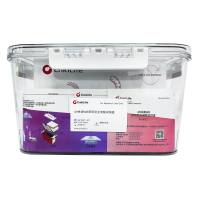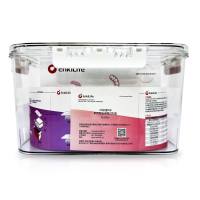Western Immunoblotting of Proteins
互联网
1. Perform SDS-polyacrylamide gel electrophoresis (SDS-PAGE) on a cell sample prepared using modified RIPA buffer and transfer the proteins to a nitrocellulose membrane.
2. Wash the nitrocellulose twice with distilled H2 O. Stain the nitrocellulose with Ponceau Red solution for 5 minutes to visual protein bands (Stock solution: 2% Ponceau S in 30% trichloroacetic acid and 30% sulfosalicylic acid; dilute 1:10 for use). Rinse the membrane in H2 O until protein bands are distinct and mark the position of the molecular weight markers with a ball point pen or pencil. The Ponceau Red stain will be washed off the membrane during the blocking step.
[Note : Do not let the blot dry out at any step through development as this will cause an increase in background staining .]
3. Block the blotted nitrocellulose membrane in freshly prepared PBS containing 3% nonfat dry milk for 20 minutes at room temperature with constant agitation. A maximum blocking time of 2 hours at room temperature should not be exceeded since staining artifact may appear. For longer blocking times, the membrane should be kept at 4¡C.
4. Dilute the primary antibody to the recommended concentration/dilution in fresh PBS/3% nonfat dry milk (please see Certificate of Analysis for detailed information). Place the nitrocellulose membrane in the primary antibody solution and incubate 1 to 2 hours at room temperature or overnight at 4¡C with agitation.
5. Wash the nitrocellulose membrane five times for 3 to 5 minutes each with either water or PBS containing 0.05% Tween 20.
6. Incubate the nitrocellulose membrane in the secondary reagent of choice for 30 minutes to 1 hour at room temperature or overnight at 4¡C with agitation. For a mouse monoclonal antibody, a goat-anti-mouse HRP conjugated antibody is recommended, for a rabbit polyclonal antibody, a goat-anti-rabbit HRP conjugated antibody is advisable.
7. Wash the nitrocellulose membrane five times for 3 to 5 minutes each with either water or PBS containing 0.05% Tween 20. If the membrane has been washed with water, a final wash step for 3 to 5 minutes in PBS containing 0.05% Tween 20 should follow.
8. Rinse the nitrocellulose briefly in 4 to 5 changes of water, then perform detection of proteins using a detection system of choice, e.g., enhanced chemiluminescence (ECL).
TIP: If it does not inhibit antibody binding, Tween 20 (0.05% final concentration) can be added to the blocking and antibody solutions as well to reduce nonspecific background staining.








